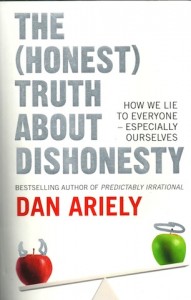The one-sentence summary
We lie to everyone, especially ourselves, but our propensity to do so hinges on the amount to be gained and the probability of being caught.
WHAT THE BOOK SAYS 
- We lie to everyone, especially ourselves. Our propensity to do so hinges on the amount to be gained and the probability of being caught. If the amount is small, and the chances of being caught are high, we tend to behave ‘normally’ – that is to say, we all cheat a bit anyway.
- Lots of factors increase dishonesty:
1. Cultures that give examples of dishonesty (think Enron)
2. Watching others behave dishonestly
3. Seeing others benefiting from it (just one person is enough in each case)
4. Being depleted, such as tired or hungry (when we suffer ‘ego depletion’, we are more likely to lie, to ourselves in particular)
5. Witnessing just one immoral act
6. Creativity (creative people are more dishonest because they can invent cleverer excuses, stories, and rationales)
7. Conflicts of interest (experts such as dentists suggesting treatments)
8. Ability to rationalise (dishonesty also increases with intelligence)
- Dishonesty can be decreased by supervision, moral reminders, and having people sign up or swear to pledges (particularly religious ones).
- The simple model of rational crime (SMORC) suggests that cheating is the benefit of a cost-benefit analysis, but this research suggests it isn’t.
WHAT’S GOOD ABOUT IT
- 1% people are always honest, and 1% always dishonest. The remaining 98% are honest if the conditions are right. Locks on doors don’t really stop people getting in – they simply act as moral reminders.
- Golfers cheat, and they even lie about lying – they give themselves an 8% likelihood of cheating, but score other golfers at 23%.
- Dishonesty is widespread in banking, academia, and almost every other area. It’s usually disguised as ‘fudging the numbers.’
- In an average term the author has 10% of students say their grandmother has died just before final exam papers are due.
- Self-signalling is an interesting concept – those wearing fake clothes tend to lie and cheat more because they feel lacking in authenticity.
- The “What-the-hell” Effect occurs when dieters have been disciplined all day, and then have just one piece of chocolate. As soon as they do, they’ll probably eat the whole bar.
- An immorality virus can spread if we see someone get away with dishonesty.
- Resetting our moral compass can be done, and is the role often performed by religious rituals, as well as New Year resolutions.
WHAT YOU HAVE TO WATCH
- The author is not surprisingly obsessed with running experiments, so it’s easy to be cynical about yet another bunch of college students performing one of his seemingly endless tests – often with predictable results.
